Most wine writing in wine magazines is boring and formulaic. What does that tell us? A logical conclusion to draw is that if you want to be a successful published wine writer then you need to learn how to write boring, formulaic wine articles, because this is clearly what the market is looking for.
So I’m here to help. I’m going to tell you the secrets – give you the inside track – on how to write just such an article.
First of all, you need to take a press trip. Two or three days in wine region X, paid for by a generic body, where you get to visit a mix of producers. Travelling with a group of fellow writers, you’ll be taken to see one or two boutique producers, one or two larger producers, and some lousy huge producers who pay a lot of money to support the generic body. The exact itinerary, of course, will mostly be determined by internal politics. [Bad producers, you see, don’t realise that it would be better for them if journalists just visited the best producers in any particular region.]
So you then get a commission from a magazine editor to write about wine region X. It works out quite nicely, because if region X has the money to host journalists, they’ll also have money for advertising, so magazine editors will be looking to commission articles on region X. They will want 1500-1800 words, and they’ll pay you between £225 and £250 per 1000 (a rate that has not budged in 15 years).
So how do you write your boring wine article? You haven’t got room to go into depth, so remember: big overview without too many specifics. The good news: it won’t take long to do, especially if you follow my template here.
Start off with how 30 years ago region X wasn’t making very good wines, despite the obvious potential of the vineyards and the grape varieties that were grown here. Then explain the work of the pioneers. People who began making slightly better wines than their peers. Mention between one and four producers who found out that if they made better wines, they could charge more for them, and how they realized they were onto a winning streak when they won a trophy at a competition or got a 90+ score from Robert Parker.
Then put some facts in. How many hectares? Which varieties? What’s the climate like?
Two paragraphs in, begin inserting a few quotes from some of the producers you visited. The blander and more generic the better. Keep it positive.
Say how some producers are small, some are medium sized, and some are big. Remark on how good the quality of the big producers is, considering how big they are.
Talk about the viticulture and winemaking. Explain that some of the vineyards are new plantings, whereas others are older. Explain that the best wines come from old vines on the best terroirs. Point out that some terroirs are better than others, and how the range of soil types varies across the region. You’ll need to put a quote in from one of the people you visited describing their soils, because you don’t know what the geological terms they are using means. [It’s OK. No one does.] Mention the grape varieties that are grown here. Some of them are white and some are red. There are different clones and some of the clones are better than others. Some wines are varietal and some are blends. Sometimes blends are better than varietal wines, but sometimes they are not. Some producers use oak and some use stainless steel. Some use both.
Some producers are traditionalists and some are modernists. Some people think the traditionalists are right, but others think the modernists are better. Some producers are traditional, but in a modern sort of way.
Take a personal angle. Tell (briefly) the story of winegrower Y who had a passion for winemaking and how they bought a small vineyard and lavished it in passion, and then gradually grew their business by making slightly better wines each year and gradually increased their vineyard holdings because of their passion for wine. And explain carefully that some old winemakers are retiring and new winemakers are starting out.
But don’t deflect from your narrative theme, which is thus: everything is getting just a little bit better. [I think I have Richard Neill to thank for this insight, but I can’t find the original quote anywhere.] The wines being made today are better than those being made a few years ago, and because everyone is so passionate and motivated we can confidently predict that things will continually to improve, little by little.
The crunch. At this stage you’ll be worrying that your article is beginning to read like an advertorial. [Which it sort of is.] So you’ll need a crunch. This is the time to introduce two or three mild threats or challenges to the ever-improving wine quality, but it’s best that these challenges are fairly easily surmountable, or – even better – have already been successfully overcome. They could include a recent vintage that wasn’t quite as good as another, or the risk of hail, or exchange rate instability, or the shortage of donkeys for old-style vineyard work.
To finish. The conclusion. The future is bright, and the wines from region X are better than ever, and you should probably be buying them.
This is the stage where you recommend five producers, so take a spread from the different scale and quality levels of those you saw. And pick a wine from each and give it a vague generic description. Job done. No need to thank me, just trying to help.
28 Comments on How to succeed as a wine writer by writing boring wine articles


Gold.
Jamie: I don’t often read generic wine essays, but you hooked me; good fishing to you! I prefer needs-specific articles, and those of people I’ve come to respect as informative and can develop mutual respect.
Jamie, is part two on how to illustrate your article for a few extra quid 🙂 ?
That’s you sacked by publication Z… Thought you loved a generic junket ; )
While this is very true, most travel articles (in the US, at least, the UK is better) are even more boring than most wine articles.
It’s easy to blame the writers, but really it’s the editors, and looking larger, the publications themselves. They’re not looking for pieces on one quirky, interesting person or place, at least not for freelancers. They want generic, so the professional writer gives them what they want.
Personally, I have always been unable to sell my very best stories. But I have had success selling editors exactly what they want. And one must pay the rent.
Sorry mate, I got through the first coupla paragraphs of your piece but from there-on it became fairly generic, formulaic and bland wine-writing. You’ll have to do better than this… 😉
I love it! With a database of a few terms and a random number generator, you could almost get the computer to write it for you.
I’ll never be able to read Decanter in the same light now.
Well, this last issue of Decanter is looking pretty bland now…
Tom Downey just had an exact example of this published, about Mt. Etna, in the February Wall Street Journal Magazine. Four producers, and a great reference to ‘voluble acidity.’
how to write generic critic about boring generic wine articles by depicting what they write about XD jk
Brilliant!! I was wondering why I keep skipping these articles in the magazines, but now I know! This gives a good perspective on the boringness of the repetitive and advertorial-style articles we are constantly confronted with. Wine magazines should have more guts!!!!!
Brilliant.
Oh god, this is so true! But how will I write next wine article?
Big smile on my face, on this dreary Monday!!!
Oh, and you should add: repeat this every 3 to 5 years for region X.
Holy cripes there is an elephant in the room, and with all of these polite wine producers present– and reading this. Please get him to leave presently. The future of the word junket is at stake.
Great stuff, Jamie! (Speaking as someone who, like you, trudged through countless examples while judging for the Roederer awards).
Bookmarking this for critical self-analysis ;o)
This is really funny. Didn’t know you were such a cynic!
Well, I’ll put my hand up and say we’ve published a fair few generic wine pieces. In my defence, I’ll add that I’ve tried on many occasions to break the mould. The problem is that truly great writing takes a lot of work… and courage. Nobody turns in a great piece straight off the bat – it needs an editorial back-and-forth and about three preliminary discussion or later rewrites. Very few people are prepared to do that (not surprisingly) for the money offered.
Which is why what the wine world needs is Jeremy Clarkson
http://www.thetastingnote.com/2015/01/520-what-wine-world-needs-now-is-love.html
Glorious.
Don’t forget, you also need a pair of grubby hands holding a bunch of grapes. If the winemaker isn’t about, the bus driver will do nicely. This is also a great time to point out the colour of the soil on the grubby hands 🙂
Great article, Jamie. I do like meta-articles. There’s not enough of them about in general.
Thank you for the template for my first blog, I love it
Is this tweetable?
Can we also have the “tasting note essentials”, so we don’t miss a bit of the leather, frogs pee, and lavender, the mouth feel, tannins, colour wheel, and length
Bloody love it James. Busted a gut laughing. At last, someone in the wine industry with a sense of humor. Thank feck for that!
Oh Jamie you took the words right out of my mouth. Those group tours and then the savage Editing of any original thought in the writing that makes other boring scribes look ..well ..boring…